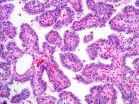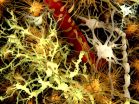(Press-News.org) People may have been making their way from Easter Island to the Americas well before the Dutch commander Jakob Roggeveen arrived with his ships in 1722, according to new genomic evidence showing that the Rapanui people living on that most isolated of islands had significant contact with Native American populations hundreds of years earlier. The findings reported in the Cell Press journal Current Biology on October 23 lend the first genetic support for such an early trans-Pacific route between Polynesia and the Americas, an impressive trek of more than 4,000 kilometers (nearly 2,500 miles).
The findings are a reminder that "early human populations extensively explored the planet," says Anna-Sapfo Malaspinas from the Natural History Museum of Denmark's Centre for GeoGenetics. "Textbook versions of human colonization events—the peopling of the Americas, for example—need to be re-evaluated utilizing genomic data."
On that note, a second article that will appear in the same issue of Current Biology by Malaspinas along with Eske Willerslev and their colleagues examined two human skulls representing the indigenous "Botocudos" of Brazil to find that their genomic ancestry is Polynesian, with no detectable Native American component at all.
Archaeological evidence had suggested that 30 to 100 Polynesian men, women, and children first landed on Easter Island, also known as Rapa Nui, around AD 1200, arriving in two or more double-hulled canoes. After settling on the isolated island, the Rapanui famously built giant stone platforms and over 900 statues, some weighing as much as 82 tons.
While it may have taken weeks for Polynesians to reach even the closest nearby islands, there are hints of contact with the larger world. For example, there is evidence for the presence of crops native to the Americas in Polynesia, including the Andean sweet potato, long before the first reported European contact.
Genome-wide analysis of 27 native Rapanui now confirms significant contact between the island people and Native Americans sometime between approximately AD 1300 and AD 1500, 19 to 23 generations ago. The Rapanui population began mixing with Europeans only much later, in about 1850. The ancestry of the Rapanui today is ?76% Polynesian, 8% Native American, and 16% European.
The new evidence about the Rapanui suggests one of two scenarios: either Native Americans sailed to Rapa Nui or Polynesians sailed to the Americas and back. The researchers say that it seems more likely that the Rapanui successfully made the trip back and forth, given simulations presented in previous studies showing that "all sailing voyages heading intentionally east from Rapa Nui would always reach the Americas, with a trip lasting from two weeks to approximately two months." On the other hand, the trip from the Americas to Rapa Nui is much more challenging, which would have made it likely to fail or miss the island completely. From the Americas, Rapa Nui is indeed a small target, which might also explain why it took Europeans so long to find it.
INFORMATION:
Current Biology, Moreno-Mayar et al.: "Genome-wide ancestry patterns in Rapanui suggest pre-European admixture with Native Americans."
Genomic data support early contact between Easter Island and Americas
2014-10-23
ELSE PRESS RELEASES FROM THIS DATE:
Paper-based synthetic gene networks could enable rapid detection of ebola and other viruses
2014-10-23
Synthetic gene networks hold great potential for broad biotechnology and medical applications, but so far they have been limited to the lab. A study published by Cell Press October 23rd in the journal Cell reveals a new method for using engineered gene circuits beyond the lab, allowing researchers to safely activate the cell-free, paper-based system by simply adding water. The low-cost, easy-to-use platform could enable the rapid detection of different strains of deadly viruses such as Ebola.
"Our paper-based system could not only make tools currently only available ...
Thyroid cancer genome analysis finds markers of aggressive tumors
2014-10-23
ANN ARBOR, Mich. — A new comprehensive analysis of thyroid cancer from The Cancer Genome Atlas Research Network has identified markers of aggressive tumors, which could allow for better targeting of appropriate treatments to individual patients.
The finding suggests the potential to reclassify the disease based on genetic markers and moves thyroid cancer into a position to benefit more from precision medicine.
"This understanding of the genomic landscape of thyroid cancer will refine how it's classified and improve molecular diagnosis. This will help us separate ...
New TSRI studies bring scientists closer to combating dangerous unstable proteins
2014-10-23
LA JOLLA, CA – October 23, 2014 - Scientists at The Scripps Research Institute (TSRI) have discovered a way to decrease deadly protein deposits in the heart, kidney and other organs associated with a group of human diseases called the systemic amyloid diseases.
"If we can develop a strategy to reduce the load that's coming from these proteins, then we can open up treatment options that could be broadly applied to treat multiple systemic amyloid diseases," said Luke Wiseman, assistant professor at TSRI and a senior author of the new research.
In related studies ...
California's tobacco control efforts losing steam, finds UCSF report
2014-10-23
California's position as a leader in tobacco control is under threat, according to a new report from the UC San Francisco Center for Tobacco Control Research and Education. Once a highly successful program and international model, the state's anti-tobacco efforts now appear to be waning due to the decreased spending power of the California Tobacco Control Program, a resurgence of the tobacco industry in state politics, and the emergence of new unregulated tobacco products.
"The combination of weak leadership at the state level, willingness of political leaders to accept ...
YEATS protein potential therapeutic target for cancer
2014-10-23
Federal Express® and UPS® are no match for the human body when it comes to distribution. There exists in cancer biology an impressive packaging and delivery system that influences whether your body will develop cancer or not.
One area of interest focuses on histones, the chief component of chromatin, a cluster of large molecules. Aberrations in chromatin are thought to lead to DNA damage such as with cancer. Researchers at The University of Texas MD Anderson Cancer Center announced findings indicating a possible new way of manipulating chromatin and its histones ...
New insight on why people with Down syndrome invariably develop Alzheimer's disease
2014-10-23
La Jolla, Calif., October 23, 2014 –A new study by researchers at Sanford-Burnham Medical Research Institute reveals the process that leads to changes in the brains of individuals with Down syndrome—the same changes that cause dementia in Alzheimer's patients. The findings, published in Cell Reports, have important implications for the development of treatments that can prevent damage in neuronal connectivity and brain function in Down syndrome and other neurodevelopmental and neurodegenerative conditions, including Alzheimer's disease.
Down syndrome is characterized ...
Cancer exosome 'micro factories' aid in cancer progression
2014-10-23
Exosomes, tiny, virus-sized particles released by cancer cells, can bioengineer micro-RNA (miRNA) molecules resulting in tumor growth. They do so with the help of proteins, such as one named Dicer. New research from The University of Texas MD Anderson Cancer Center suggests Dicer may also serve as a biomarker for breast cancer and possibly open up new avenues for diagnosis and treatment. Results from the investigation were published in today's issue of Cancer Cell.
"Exosomes derived from cells and blood serum of patients with breast cancer, have been shown to initiate ...
TCGA study improves understanding of genetic drivers of thyroid cancer
2014-10-23
A comprehensive analysis of the genomes of nearly 500 papillary thyroid carcinomas (PTC) – the most common form of thyroid cancer – has provided new insights into the roles of frequently mutated cancer genes and other genomic alterations that drive disease development. The findings also may help improve diagnosis and treatment. Investigators with The Cancer Genome Atlas (TCGA) Research Network identified new molecular subtypes that will help clinicians determine which tumors are more aggressive and which are more likely to respond to certain treatments. Their ...
Helping sweet cherries survive the long haul
2014-10-23
SUMMERLAND, BRITISH COLUMBIA - A new study says that cherry producers need to understand new intricacies of the production-harvest-marketing continuum in order to successfully move sweet cherries from growers to end consumers. For example, the Canadian sweet cherry industry has had to modify logistics strategies--from shorter truck or air shipping to long-distance containerized shipping--to accommodate burgeoning export markets. Keeping cherries fresh and consumer-ready during long ocean crossings challenges producers to find new ways to retain fruit quality for weeks. ...
Study finds significant increase in type 1 diabetes rates among non-Hispanic white youth
2014-10-23
PASADENA, Calif., October 23, 2014 — The rate of non-Hispanic white youth diagnosed with type 1 diabetes increased significantly from 2002 to 2009 in all but the youngest age group of children, according to a new study published today in the journal Diabetes.
The study included data from more than 2 million children and adolescents living in diverse geographic regions of the United States. Within this population, researchers identified 5,842 non-Hispanic white youth, 19 years old and younger, newly diagnosed with type 1 diabetes over the 8-year study period. They ...








